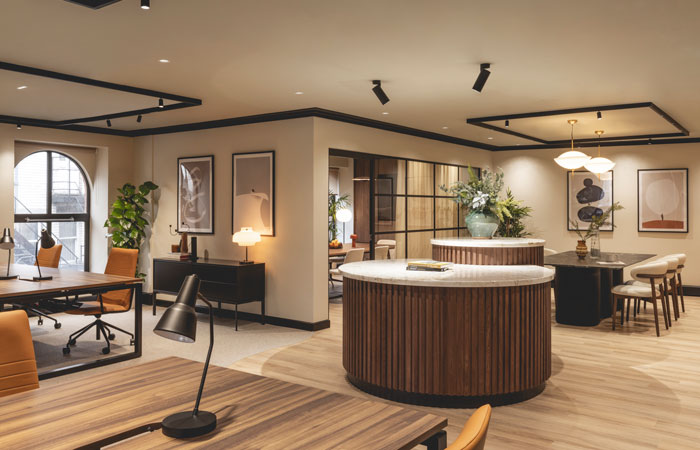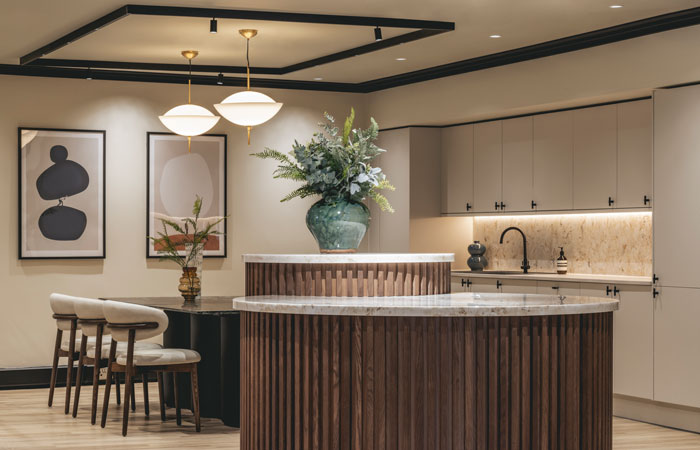Jolie embrace ‘hotelization’ to set a new standard for workplace luxury
International design studio Jolie is proud to announce the completion of the highly anticipated redesign of Clarence House, located in the heart of Manchester’s city centre within the Albert Square conservation area.

The revitalised Clarence House sets a new standard for workplace luxury, catering to high-end professionals in the legal, finance, and property sectors who are seeking a prestigious and inspiring environment that is designed to facilitate growth while supporting the mental wellbeing of staff.

The concept of the traditional workplace has evolved significantly in the wake of the pandemic, with a greater emphasis on community and social sustainability. At Clarence House, Jolie has embraced this paradigm shift by incorporating elements reminiscent of a boutique lifestyle hotel into its design, combining comfort, style and a nod to residential aesthetics, while transcending traditional commercial design choices and materials.
“We relished this opportunity to create a boutique workplace within the walls of this beautiful 19th-century building steeped in architectural detail and history,” says Jolie CEO and Founder, Franky Rousell. “Our goal was to make the office a destination with a purpose, embracing the ‘hotelization’ of the office space by importing the comforts of home – such as relaxed dress codes, real planting, and soft furnishings – while maintaining a crisp, immaculate aesthetic. This trend reflects a broader evolution in how we at Jolie approach workplace design, and the recognition that employees thrive in environments that prioritise well-being, community, and a sense of belonging.”
The ‘hotelization’ of the workplace

The ‘hotelization’ of office space goes beyond aesthetics, encompassing a holistic approach that considers the entire employee experience. As a sensory-led design studio, Jolie believes that incorporating scientific sensory research to emotionally drive people in their environment will allow workspace providers to differentiate themselves in oversaturated city environments like Manchester, or London, and successfully attract potential clients over their competition.

By tailoring the interior environment to the needs of high-end professionals, rather than tech startups or creative agencies, Jolie has given Clarence House the edge it needs to attract discerning business owners who understand the value of investing in their people and brand through their office space.
“The target customers are global travellers and big earners who seek experience-driven spaces for their workforce,” explains Rousell. “At Clarence House, they will find a destination that offers a sanctuary akin to a luxury hotel environment, fostering a sense of belonging, pride, and exclusivity for their team.”

An immersive experience
To achieve this, Jolie has meticulously designed every aspect of the space to create a truly immersive experience. Even before entering the building there has been a deliberate emphasis on creating a warm and inviting atmosphere through considered lighting design, luxurious materials and attention to detail in signage and entryways, which all contribute to creating a premium first impression.

The main entrance has been transformed with sleek modern glass and stealthy black metal frame-work doors, while the facade has been uplifted through cleverly placed lighting and box hedge planting, ensuring a striking street presence both day and night. Throughout the building, textured dark timbers, brass joinery openings, and soulful marble details ensure a seamless transition between spaces. Within the workspace, flexible and comfortable aesthetics take precedence, with soft furnishings, greenery, and residential touches creating a sense of ease and relaxation.
“Colour is intrinsically linked to the psyche,” says Rousell, “and plays a huge role in helping to define a person’s mood. Different hues and shades can make people feel creative, reduce anxiety, calm or motivate them. When used correctly and striking an optimal balance, colour has an incredible potential to influence how an end user feels and behaves in a space.”

At Clarence House, Jolie has used a gentle orange hue in the upholstery of the office chairs. “Orange is typically considered the most creative colour,” says Rousell, “sparking open-minded solutions to creative problems. When overused though, it can induce anxiety and in turn hinder the creative process. So moderation and understanding of the effect of colour is key to creating meaningful spaces.”

Likewise the considered use of green tones throughout the building – in the plush velvet upholstery of the lobby lounge, half height tiling in many communal areas and the abundance of foliage throughout the building – is designed to bring balance and security, helping to create feelings of optimism, health and calmness.
Social Sustainability
Jolie is committed to creating spaces that foster positive attitudes, encourage sustainable behaviours and build up communities. At Clarence House, collaborative areas resemble hotel lobbies, where team members can gather, exchange ideas, and build connections, while meeting rooms and breakout areas are specifically designed to facilitate focus, collaboration, and relaxation.

In the basement, unisex showers with private changing facilities, communal WC and vanity stations, as well as EV charging stations and ample bike and scooter storage, demonstrate Clarence House’s commitment to sustainability and well-being.

“As the trend towards ‘hotelization’ continues to reshape the workplace landscape, business owners and CEOs must recognize that creating an exceptional workplace environment goes beyond the physical space; it involves fostering a sense of pride, exclusivity, and belonging among their employees,” says Rousell. “Investing in a workspace that reflects luxury, class, and status, business owners and CEOs send a clear message to their teams: We value you, and we want you to thrive.”




